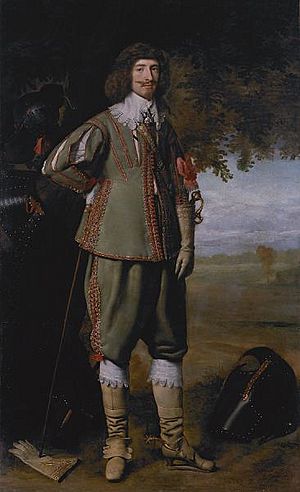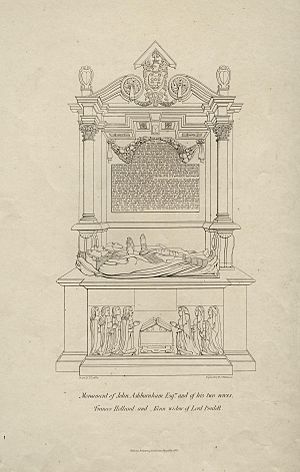John Ashburnham (Royalist) facts for kids
John Ashburnham (born 1603 – died 15 June 1671) was an important English figure during a time of great change. He was a courtier, which means he served the King, and also a diplomat and politician. He was a member of the House of Commons at different times between 1640 and 1667. John Ashburnham was a strong supporter of the King, Charles I, during the English Civil War. He was known as a loyal "Royalist" and stayed close to the King.

Contents
Early Life and Royal Connections
John Ashburnham was the oldest son of Sir John Ashburnham. His mother, Elizabeth, was related to Lady Villiers, who was the mother of George Villiers, 1st Duke of Buckingham. Buckingham was a very powerful friend of King Charles I.
Because of this connection, John Ashburnham became well known to King Charles I. The King even called him "Jack Ashburnham" in his letters, showing their close relationship. In 1628, John Ashburnham became a "groom of the bedchamber." This was an important role, meaning he was a personal attendant to the King.
How John Ashburnham Became Wealthy
John Ashburnham became quite wealthy during this time. He even lent money to the King. In 1638, he was given money from a fine paid by another person. The next year, he was able to get back his family's old estate in Ashburnham.
In 1640, he became a member of parliament for Hastings in the Long Parliament. However, he was a strong supporter of the King, which caused problems with Parliament. He started to miss meetings. Parliament then took action against him. The King wrote a letter to Parliament to defend him, but Parliament insisted he must obey their rules. Ashburnham was removed from his position in Parliament in 1643, and his property was taken.
John Ashburnham and the English Civil War
John Ashburnham was a very loyal friend and helper to King Charles I during the First English Civil War. He became the treasurer and paymaster for the King's army, managing its money.
He was involved in many peace talks during the war. For example, he was one of the people who met at the Treaty of Uxbridge in 1644. He also helped present the King's ideas to Parliament in December 1645.
Helping the King Escape
When the King's army was losing, Charles I decided to try and escape from Oxford. John Ashburnham and another man named Michael Hudson were the only two people with the King on his journey to the Scottish army camp near Newark-on-Trent.
Hudson was later released. The King then ordered Ashburnham to escape before he could be sent to London as a "delinquent" (someone who opposed Parliament). Ashburnham successfully made his way to Holland and then to Queen Henrietta Maria in Paris.
The King's Capture at Hampton Court
In 1647, the army had the King in custody at Holmby. They allowed him to choose his own servants. Ashburnham rejoined the King at Hampton Court. Here, King Charles was worried about being attacked.
Ashburnham suggested that the King propose a sudden trip to London to talk directly with Parliament. But this plan did not work out. The King was eager to leave Hampton Court. He asked Ashburnham and his other trusted friends, Sir John Berkeley and William Legge, to find a place for him to go.
Ashburnham suggested Sir John Oglander's house on the Isle of Wight. The idea was to check if the island's governor, Colonel Robert Hammond, could be trusted. If not, the King could secretly sail to France. However, Berkeley told Hammond about the hiding place. The King refused Ashburnham's desperate offer to kill Hammond, and so Charles became a prisoner again.
Life During the Commonwealth Period
After the King was captured, the new government, called the Commonwealth, caused problems for Ashburnham. He was held in the Tower of London and sent away to the Channel Islands three times.
He was separated from King Charles in January 1648 and later imprisoned in Windsor Castle. When the Second English Civil War began, he was exchanged for another prisoner. He was not allowed to be with the King during the Treaty of Newport. He was also listed among those who would not receive a pardon.
Challenges and Suspicions
Ashburnham was constantly troubled by the new government. He had gained some property from his second marriage in 1649. King Charles II, who was in exile, allowed him to stay in England to protect his estate.
However, some Royalists suspected he might not be fully loyal. He was also sued for debts that King Charles I had made. He was forced to give up half of his property. He also had to promise to appear before the council of state whenever they asked. His private travels needed permission from the council. For three years, committees questioned him about who had lent money to the King during the wars. He was sent to Guernsey Castle three times for sending money to the King.
After the King's Return (Restoration)
After the King returned to power in 1660, an event known as the Restoration, John Ashburnham served Charles II as a diplomat. He was also a member of parliament for Sussex from 1661 to 1667.
In September 1661, he led a group looking into problems with the post office. The King bought Ashburnham's house in Chiswick for the Duke of Monmouth. In January 1665, Ashburnham became one of the Duke's guardians.
The money he had lent to Charles I was paid back through grants of royal land. He and his brother William Ashburnham also worked together to restart the making of tapestry at the Mortlake Tapestry Works in 1667.
His large memorial tomb, created by Thomas Burman, can be found in St Peter's Church in Ashburnham, East Sussex.
Family Life and Legacy
John Ashburnham's daughter, Elizabeth, married Sir Hugh Smith, 1st Baronet. His grandson, John, was given the title Baron Ashburnham in 1689. Later, his great-grandson became the Earl of Ashburnham. This title ended in 1924.


